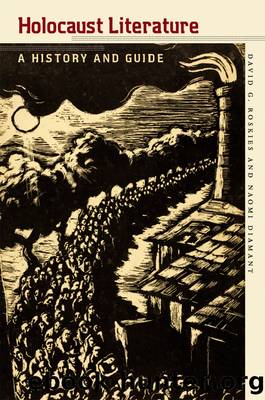Holocaust Literature by David G. Roskies

Author:David G. Roskies
Language: eng
Format: epub
Publisher: Brandeis University Press
Re-covery: How the Holocaust Book Was Made
What goes on the cover? As I write these words, the book you are holding in your hands does not yet have a cover design. This book, like any other, must follow the requisite steps and pass the usual checkpoints, from writing, revising, vetting, revising yet again, copy-editing, producing galleys, and proofreading to printing and binding, and the cover art usually falls into place when there is a place on the bookshelf about to be occupied. The most important decisionâwhat goes on the coverâis usually left for last.
So let us try to imagine what the editors, authors, publishers, and publicists were thinking when they chose the cover art for the twenty covers that lie scattered throughout this volume in black-and-white, some of which also appear in a beautiful full-color insert in the middle. Those who brought Holocaust literature to the light of day did not yet know what we know: that these covers, which cover the years 1946â95, would mimic the movement from the communal to provisional to authorized memory of the Holocaust. Rather, each was working in the present, hoping to find a mnemonic for the past and a link to the future.
Some things change, and others remain constant. The choice of style is always made with a specific audience in mind. Whether the graphic style be mimetic or symbolic, commercial or high modern, will depend on the wished-for audience. Is this awesome subject intended only for readers with a genetic, confessional, geographic, or linguistic claim to the map of origins, or should the locus of identification lie elsewhere, in domains more personal, psychological, and existential? Who and what stands in for the Holocaust? A mother and child, a husband and wife, or only the child, alone? A ghetto or a concentration camp, or will a hiding place be sufficient to inspire terror and awe? Barbed wire or a crematorium, or will a brick wall do? A number, a letter, or a yellow star? The fire, the smoke, or the sun?
What does change is that a switch occurs when Holocaust literature comes into its own. This is the famous and âinevitable âcultural lagâ between the emergence of the new and the development of a vocabularyâbe it conceptual or artisticâto describe itâ (N. Levi and Rothberg 2003a, 6). At a certain point in time, which can now be located with precision, Holocaust literature becomes a self-conscious genre, and the cover designs illuminate the way. There comes a time when a Holocaust book can be judged by its cover.
Download
This site does not store any files on its server. We only index and link to content provided by other sites. Please contact the content providers to delete copyright contents if any and email us, we'll remove relevant links or contents immediately.
4 3 2 1: A Novel by Paul Auster(12260)
The handmaid's tale by Margaret Atwood(7660)
Giovanni's Room by James Baldwin(7161)
Asking the Right Questions: A Guide to Critical Thinking by M. Neil Browne & Stuart M. Keeley(5598)
Big Magic: Creative Living Beyond Fear by Elizabeth Gilbert(5575)
Ego Is the Enemy by Ryan Holiday(5263)
The Body: A Guide for Occupants by Bill Bryson(4945)
On Writing A Memoir of the Craft by Stephen King(4846)
Ken Follett - World without end by Ken Follett(4617)
Adulting by Kelly Williams Brown(4462)
Bluets by Maggie Nelson(4458)
Eat That Frog! by Brian Tracy(4407)
Guilty Pleasures by Laurell K Hamilton(4339)
The Poetry of Pablo Neruda by Pablo Neruda(4016)
Alive: The Story of the Andes Survivors by Piers Paul Read(3953)
White Noise - A Novel by Don DeLillo(3935)
Fingerprints of the Gods by Graham Hancock(3922)
The Book of Joy by Dalai Lama(3879)
The Bookshop by Penelope Fitzgerald(3761)
